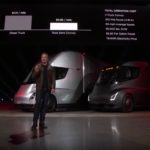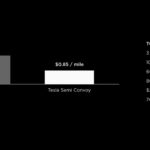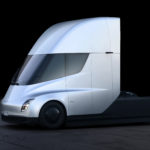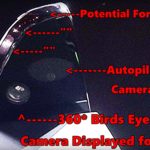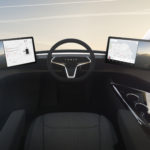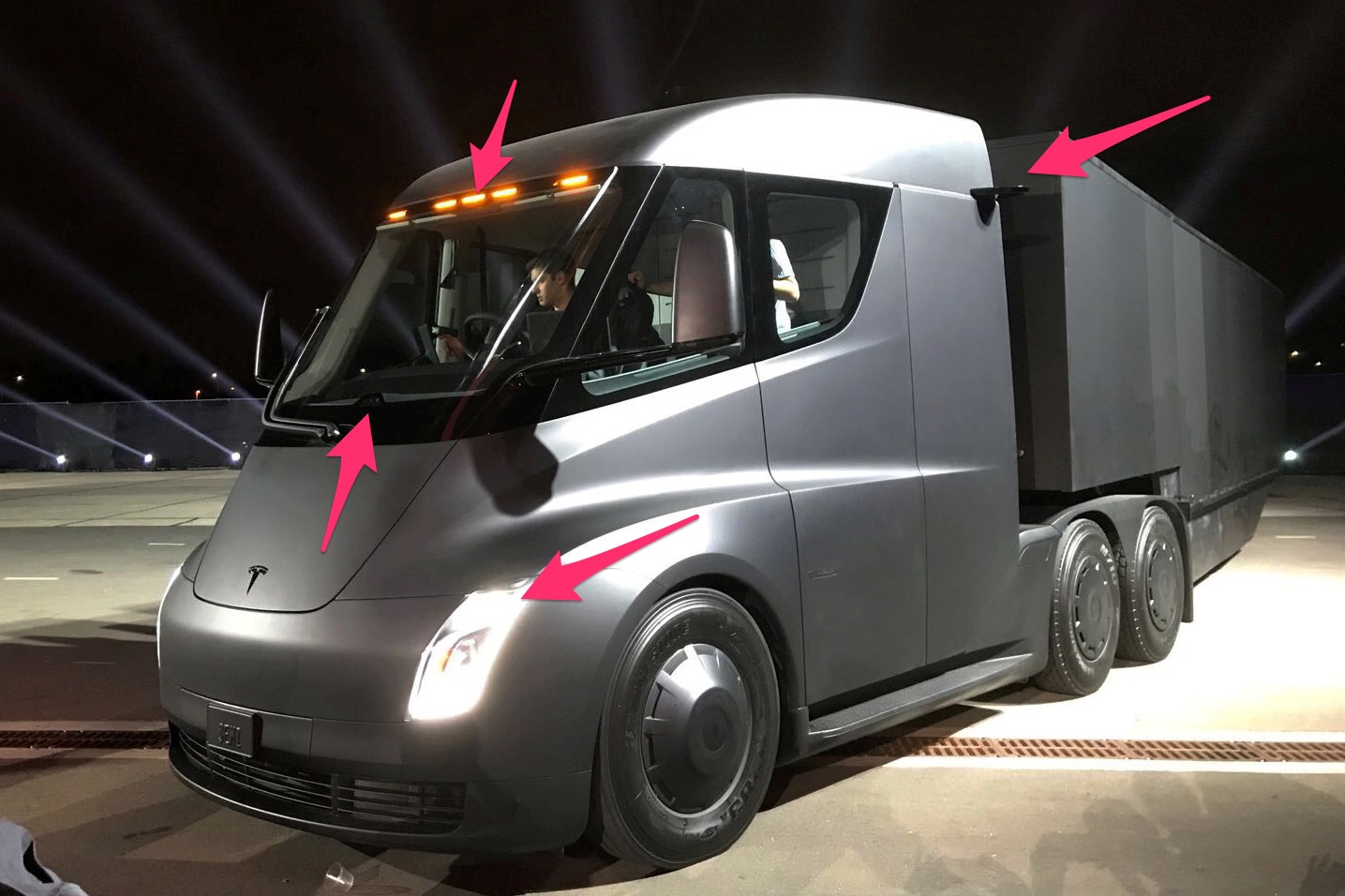
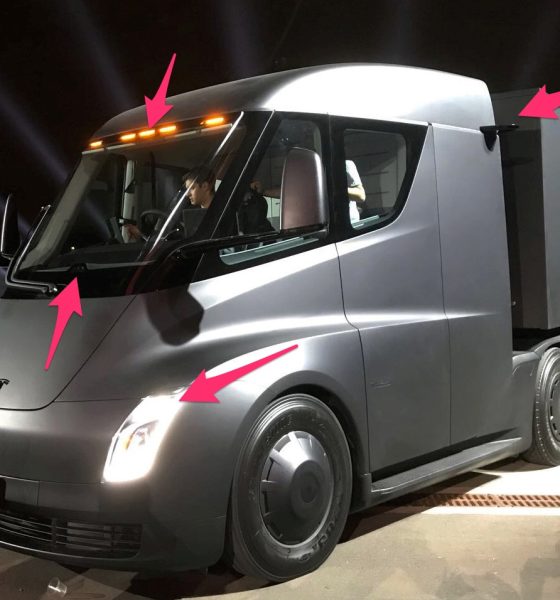
News
Tesla Semi’s vast array of Autopilot cameras and sensors for convoy mode spotted
When CEO Elon Musk unveiled the Tesla Semi to the world, one of the main messages in his presentation was that the all-electric semi-truck is significantly cheaper to own than a traditional diesel truck. With a starting price of $150,000 for the base truck, and $180,000 for the long range 500-mile variant, the Tesla Semi is priced considerably lower than what many industry experts expected.
“We really thought about this a lot. If you take everything into account: take the lease cost, take the insurance cost, maintenance, all of the factors – the fully accounted for true cost of trucking – a diesel truck will be 20% more expensive than a Tesla Semi per mile.” said Musk.
The Tesla Semi is able to achieve high efficiency through the use of four electric motors – the same volume production motors used in the company’s consumer mass market Model 3 sedan – that operate independently to control torque at each wheel. The drivetrain’s design not only allows for blistering acceleration, by truck standards, but also adds an element of safety. “The truck will automatically stop jackknifing because it has independent motors on each wheel and it will dynamically adjust the torque on each wheel so that jackknifing is impossible. Your worse nightmare is gone with this truck.”
However, combined with the truck’s ability to leverage convoy technology wherein a fleet of Tesla semi-trucks semi-autonomously draft in close proximity to one another thereby reducing energy usage from wind resistance, Tesla Semi’s true cost of ownership becomes even more favorable than a diesel truck.
“The convoy technology, the tracking technology, this is something that we are confident we can today do ten times safer than a human driver.” said Musk at the Tesla Semi unveiling event. “I want to be clear, this is something we can do now.”
According to Musk, a diesel truck becomes twice as expensive as a Tesla all-electric truck that’s operating in convoy mode.
Similar to Tesla’s Autopilot-enabled Model S and Model X consumer vehicles, the Tesla Semi is able to use a suite of cameras and sensors to paint a digital picture of its surroundings. Every truck is equipped with Enhanced Autopilot that will allow the vehicle to semi-autonomously stay in lane, automatically brake in emergency situations and warn of forward collisions.
DON’T MISS: Close-up look at Tesla Semi’s “Megacharger” charging port
“Even if you’re in an emergency, the truck will stay in lane, and gradually come to a halt, and put on the emergencies. If it doesn’t hear a response from you, it will actually call emergency services and get an ambulance. It’s going to take care of you; it’s going to take care of other cars; it’s going to take care of other pedestrians. This is a massive increase in safety.” said Musk.
On the outside, the sleek Tesla Semi doesn’t appear to have any protruding hardware beyond a “wing” that’s present on either side of the truck. Upon closer investigation by KmanAuto who attended the event and gave us a first look at the Tesla Semi’s gearbox, there’s a vast array of cameras and possibly a LiDAR mounted within the truck’s wings.
- (Credit: Tesla)
Because the Tesla Semi doesn’t have any side mirrors, video from these cameras likely provide the driver with a birds eye view of both sides of the truck as seen from the interior touchscreen displays. Kman also discovered a row of cameras mounted below and above the massive windshield, and even more cameras discreetly mounted within Tesla Semi’s headlight assembly.
Though Musk did not talk about the integration of Full Self-Driving capabilities in the Tesla Semi, Kman notes that it could be possible if Tesla one day offers its own tractor trailers with sensors. “I think Tesla will offer its own tractor trailers. These trailers will be outfitted with their own suite of sensors to enhance the vehicle’s abilities further.” Kman tells Teslarati.
We’ve embedded Kman’s video that captures the various locations of Tesla Semi’s sensor suite. We count at least 12 cameras. How many can you spot?

News
Tesla FSD fleet is nearing 7 billion total miles, including 2.5 billion city miles
As can be seen on Tesla’s official FSD webpage, vehicles equipped with the system have now navigated over 6.99 billion miles.

Tesla’s Full Self-Driving (Supervised) fleet is closing in on almost 7 billion total miles driven, as per data posted by the company on its official FSD webpage.
These figures hint at the massive scale of data fueling Tesla’s rapid FSD improvements, which have been quite notable as of late.
FSD mileage milestones
As can be seen on Tesla’s official FSD webpage, vehicles equipped with the system have now navigated over 6.99 billion miles. Tesla owner and avid FSD tester Whole Mars Catalog also shared a screenshot indicating that from the nearly 7 billion miles traveled by the FSD fleet, more than 2.5 billion miles were driven inside cities.
City miles are particularly valuable for complex urban scenarios like unprotected turns, pedestrian interactions, and traffic lights. This is also the difference-maker for FSD, as only complex solutions, such as Waymo’s self-driving taxis, operate similarly on inner-city streets. And even then, incidents such as the San Francisco blackouts have proven challenging for sensor-rich vehicles like Waymos.
Tesla’s data edge
Tesla has a number of advantages in the autonomous vehicle sector, one of which is the size of its fleet and the number of vehicles training FSD on real-world roads. Tesla’s nearly 7 billion FSD miles then allow the company to roll out updates that make its vehicles behave like they are being driven by experienced drivers, even if they are operating on their own.
So notable are Tesla’s improvements to FSD that NVIDIA Director of Robotics Jim Fan, after experiencing FSD v14, noted that the system is the first AI that passes what he described as a “Physical Turing Test.”
“Despite knowing exactly how robot learning works, I still find it magical watching the steering wheel turn by itself. First it feels surreal, next it becomes routine. Then, like the smartphone, taking it away actively hurts. This is how humanity gets rewired and glued to god-like technologies,” Fan wrote in a post on X.
News
Tesla starts showing how FSD will change lives in Europe
Local officials tested the system on narrow country roads and were impressed by FSD’s smooth, human-like driving, with some calling the service a game-changer for everyday life in areas that are far from urban centers.

Tesla has launched Europe’s first public shuttle service using Full Self-Driving (Supervised) in the rural Eifelkreis Bitburg-Prüm region of Germany, demonstrating how the technology can restore independence and mobility for people who struggle with limited transport options.
Local officials tested the system on narrow country roads and were impressed by FSD’s smooth, human-like driving, with some calling the service a game-changer for everyday life in areas that are far from urban centers.
Officials see real impact on rural residents
Arzfeld Mayor Johannes Kuhl and District Administrator Andreas Kruppert personally tested the Tesla shuttle service. This allowed them to see just how well FSD navigated winding lanes and rural roads confidently. Kruppert said, “Autonomous driving sounds like science fiction to many, but we simply see here that it works totally well in rural regions too.” Kuhl, for his part, also noted that FSD “feels like a very experienced driver.”
The pilot complements the area’s “Citizen Bus” program, which provides on-demand rides for elderly residents who can no longer drive themselves. Tesla Europe shared a video of a demonstration of the service, highlighting how FSD gives people their freedom back, even in places where public transport is not as prevalent.
What the Ministry for Economic Affairs and Transport says
Rhineland-Palatinate’s Minister Daniela Schmitt supported the project, praising the collaboration that made this “first of its kind in Europe” possible. As per the ministry, the rural rollout for the service shows FSD’s potential beyond major cities, and it delivers tangible benefits like grocery runs, doctor visits, and social connections for isolated residents.
“Reliable and flexible mobility is especially vital in rural areas. With the launch of a shuttle service using self-driving vehicles (FSD supervised) by Tesla in the Eifelkreis Bitburg-Prüm, an innovative pilot project is now getting underway that complements local community bus services. It is the first project of its kind in Europe.
“The result is a real gain for rural mobility: greater accessibility, more flexibility and tangible benefits for everyday life. A strong signal for innovation, cooperation and future-oriented mobility beyond urban centers,” the ministry wrote in a LinkedIn post.
News
Tesla China quietly posts Robotaxi-related job listing
Tesla China is currently seeking a Low Voltage Electrical Engineer to work on circuit board design for the company’s autonomous vehicles.

Tesla has posted a new job listing in Shanghai explicitly tied to its Robotaxi program, fueling speculation that the company is preparing to launch its dedicated autonomous ride-hailing service in China.
As noted in the listing, Tesla China is currently seeking a Low Voltage Electrical Engineer to work on circuit board design for the company’s autonomous vehicles.
Robotaxi-specific role
The listing, which was shared on social media platform X by industry watcher @tslaming, suggested that Tesla China is looking to fill the role urgently. The job listing itself specifically mentions that the person hired for the role will be working on the Low Voltage Hardware team, which would design the circuit boards that would serve as the nervous system of the Robotaxi.
Key tasks for the role, as indicated in the job listing, include collaboration with PCB layout, firmware, mechanical, program management, and validation teams, among other responsibilities. The role is based in Shanghai.
China Robotaxi launch
China represents a massive potential market for robotaxis, with its dense urban centers and supportive policies in select cities. Tesla has limited permission to roll out FSD in the country, though despite this, its vehicles have been hailed as among the best in the market when it comes to autonomous features. So far, at least, it appears that China supports Tesla’s FSD and Robotaxi rollout.
This was hinted at in November, when Tesla brought the Cybercab to the 8th China International Import Expo (CIIE) in Shanghai, marking the first time that the autonomous two-seater was brought to the Asia-Pacific region. The vehicle, despite not having a release date in China, received a significant amount of interest among the event’s attendees.
